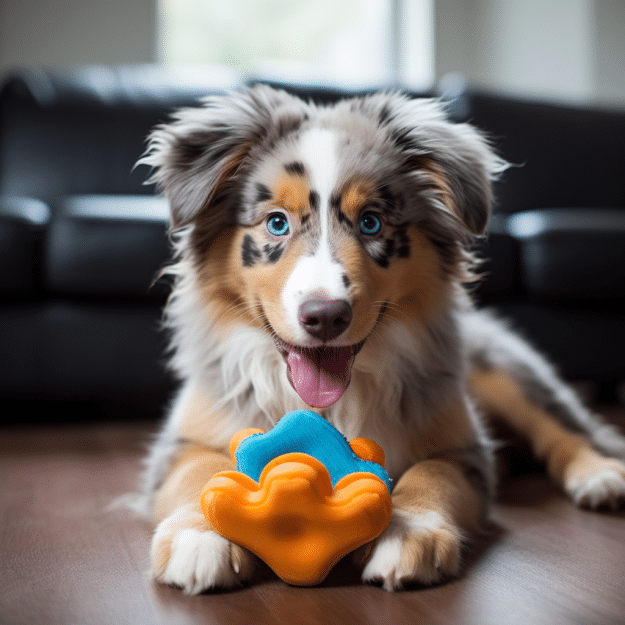All About Australian Shepherd Teething – What to Know and How to Help
Australian Shepherd Teething
Australian Shepherds are known for being full of energy and intelligence – but when they start teething, it can be a difficult time. That’s why this guide is here to help you as an Aussie puppy owner get through the Shepherd teething stage with all the insight needed. No need to worry! Let’s discover how to manage your pup’s teeth development together in order for them (and you!) to make it out unscathed.
Short Summary
- Australian Shepherds experience teething between 3-4 weeks and 8-9 months, with 28 baby teeth present by 6-8 weeks.
- Comfort your Aussie puppy during this time with chew toys, natural remedies, brushing techniques and bite inhibition training.
- Monitor changes in appetite/weight loss closely. Consult a vet if necessary to prevent dental issues from retained baby teeth.
Understanding the Teething Process in Australian Shepherds

Australian Shepherds have a rather quick teething process that begins around 3-4 weeks and ends with 28 baby teeth turning into 42 adult ones. An Aussie puppy’s dental health is very important, so they should start their journey to perfect puppies at such an early age. It’s normal for puppies of this breed to finish growing all of their permanent set by 8 months old. If not, it may be worthwhile scheduling an appointment with the vet as soon as possible just in case something else might be amiss. Taking care of your Australian Shepherd’s pearly whites during its time transitioning from pup toothies to adulthood will help lead them on the path towards healthy longevity later down the road!
Baby Teeth Eruption
Your Aussie pup’s endearing yawns and breaths can captivate all who encounter them, but just around the same time their baby teeth begin to make an appearance. Around 3-4 weeks of age, they will have grown into a full set of 28 small teeth, also known as deciduous ones, that won’t be permanent fixtures in your puppy’s mouth. Accidentally swallowing one or two during this period is not alarming. It should go through without any harm unless something unexpected arises such as discomfort or sudden changes in behaviour, then consulting with a vet would be advisable for extra precautionary measures.
Transition to Adult Teeth
When it comes to Australian Shepherds, the exchange from baby teeth to adult is like a relay. Adults start taking on their duties around 12-16 weeks of age, putting an end to puppy teething and coming into place by six months old at most. If your pup’s adult dentition isn’t in full swing after half a year, consulting with a vet should be a top priority as delays can lead to long term damage if left unaddressed. No matter when they arise though, those tooth buds are set for success!
Common Signs of Teething in Australian Shepherds

Your Aussie puppy’s teething process may come with some signs, such as your pup chewing more frequently than usual. This is because they are attempting to ease the discomfort coming from their new teeth pushing through the gums. You might observe swollen and bleeding gums, but if it persists for a long time then you should contact your vet in order to rule out other dental problems. Missing teeth will be an obvious clue that something strange is happening!
Physical Symptoms
If your Aussie puppy’s teeth are breaking through the gums, they may chew or nip excessively and drool more than usual. Other physical signs of teething might be inflamed, red gums. A low-grade fever, less eating, losing teeth which could lie around, all can cause unease in them like whining and pawing at their mouth. Although these symptoms tend to go away after the new set of buds appear fully grown, if persistent it is best to seek veterinary help.
Behavioral Changes
The teething phase of your Aussie puppy can lead to some changes in behavior. Your pup may seem less energetic, as well as more irritable and nipping excessively due to the discomfort they are feeling. This might also be coupled with red or swollen gums from continuous chewing on items like washcloths which provide a coldness that helps soothe their gum pain. It is important not to take these symptoms too seriously, once the teeth have grown in fully, this should all pass soon enough! You could help speed up this process by providing them chew toys specially designed for puppies experiencing toothaches during the teething phase. Do remember such episodes are temporary issues rather than long-term behavioural ones!
How to Comfort Your Teething Aussie Puppy

As a dedicated parent to your Aussie puppy, it is possible for you to give them comfort during their teething period. The simplest way is by offering appropriate chew toys that will help with the discomfort while dogs instinctively use chewing as part of their behavior. To provide Relief from teething distress, natural remedies like frozen bagels or tea bags along with ice cubes can be useful solutions too. If there are significant signs showing extreme pain or considerable changes in eating habits experienced by the pup, then consult your vet at once!
Chew Toys and Distractions
When it comes to comforting an Aussie puppy with sore gums, chew toys are a great solution. Providing these kinds of distractions can be highly beneficial in preventing your pup from chewing on furniture or other personal items they shouldn’t gnaw on. It is important that the chosen playthings will hold up against strong jaws. Consider plushies, rope figures, raw bones and pressed bone materials like GREENIES Dental Chews as well as Bully Sticks and KONG Classic for durable options! Nevertheless, always keep watch when they chew so there won’t be any chances of swallowing pieces too small or choking hazards.
Natural Remedies
Soothing relief can be provided to a teething puppy through natural remedies. Frozen mini bagels make for great chew toys while giving their sore gums some comfort simultaneously. Placing frozen towels and ice cubes around the area may bring instant aid from pain too! Chamomile tea or lavender tea, as well as aloe vera juice, are also effective in providing respite from teething pains – even though these should always stay low-key additions that won’t replace your pup’s diet nor its regular playthings.
Dental Care for Your Australian Shepherd Puppy

It’s vital to take good care of your Australian puppy’s oral hygiene, just like for humans. Regular brushing and regular check-ups are essential in avoiding any dental issues as well as making sure the pup’s teeth progress appropriately.
You may ask yourself how often should you inspect his/her teeth? It is recommended that owners review their Aussie dog’s mouth every couple weeks. That way they can detect potential problems quickly while still keeping proper tooth health maintenance practices going strong. Preventing anything from arising in the first place!
Brushing Techniques
Grooming your Australian puppy’s teeth can be daunting, but with the right approach, it can become a pleasant and bonding experience for both you and them. Start by brushing in their fur’s growth direction from the head using essential items like a slicker brush and long tooth undercoat rake. It is recommended to do this four times per week until they have an adult coat fully grown, then just one or two sessions weekly will suffice, not only to keep pearly whites sparkling clean but also getting used to going through these motions easily on regular basis.
Regular Check-Ups
For your dog’s oral health, regular vet check-ups should not be overlooked and are just as important for maintaining their teeth. Aussie pups need to have a dental exam at 6 months of age. This involves scaling the plaque off of their enamel and seeing if any chompers appear loose or rotten.
Visiting the veterinary clinic regularly is pivotal in detecting tooth problems quickly such as gum inflammation caused by buildup that wasn’t removed adequately – something you may find challenging to do on your own pet pup’s teeth leading to needing professional cleaning from time to time. Dental disease can also occur when adequate care isn’t taken, so it’s best practice to always take preventative steps instead!
Coping with Chewing and Biting During Teething
When your Aussie puppy is teething, they may become overly enthusiastic with their chewing habits. To ensure that these tendencies don’t transfer to inappropriate items – such as shoes and furniture – it’s essential you redirect them towards chew toys and teach bite inhibition skills. These approaches are vital in helping puppies grow up obediently without causing any destruction along the way.
By doing this, we can help our canine companions develop healthy behaviors so they transition into well behaved adults successfully!
Redirecting Chewing
When it comes to aussie puppies, chewing is something they naturally do during the teething period. One needs to make sure that these dogs chew on appropriate items in order for your possessions not to be destroyed. By providing suitable and acceptable chew toys you can fulfill their urge while at the same time protecting any treasured belongings from harm.
It’s important when buying chews for young puppies of varying sizes and personalities that there are adequate varieties available so as not just satisfy them but also prevent boredom which will help keep puppies entertained. The goal being here obviously should be making those designated pets’ products more desirable than anything else around!
Bite Inhibition Training
Aussie puppies, during their teething phase, should be taught bite inhibition. This important skill helps them regulate the strength of their bites and prevents accidental injuries in playtime situations. The best way to teach this is through positive reinforcement techniques like treats or toys when they do not nip or bite too hard. On the contrary, if they misbehave with biting too much, then taking away attention works better as a lesson than punishment does. It’s ideal for puppy owners to start teaching about bite inhibition before three months up until five months old so that it can become part of your pup’s routine behavior instead of having challenges change those habits later on.
Potential Teething Concerns and Solutions
When a teething puppy is growing, it can often bring along some difficulties. Retained baby teeth or modifications in intake and weight might be observed which are not always alarming but should still be noted to know how to respond if these situations arise. When the permanent adult teeth begin emerging, they may sometimes push out the baby ones leaving them behind. This could cause overcrowding of misaligned growth among them. Due to discomfort during this period, food cravings might also diminish resulting either considerable body mass loss or lack of appetite for extended periods thus veterinary intervention would then become necessary.
Retained Baby Teeth
During teething in Aussie puppies, it’s not unusual for baby teeth to remain in place. This happens when the adult tooth does not develop under the corresponding infant tooth, causing it to stay put instead of coming out naturally. While this may seem harmless initially, retained baby teeth can cause dental issues like overcrowding or misalignment that can lead to discomfort if left unattended. In such a case, vets usually recommend removing them altogether so as to avoid any future complications for your pup’s oral health and overall well-being. Speaking with a vet should be done quickly after noticing one or more juvenile teeth still occupying their spot among the grown ones!
Appetite Changes and Weight Loss
When your Aussie puppy’s teeth are coming in, it may affect its appetite. Eating can be painful and the pup might have a decrease of interest in food which could lead to weight loss. It is essential for the owner to take their pet to a veterinarian if they see an extensive lack of hunger or slimming down over time. The vet will rule out any illnesses that could influence this change in behavior while providing solutions like chew toys and specialized foods tailored towards easing sore gums during teething stages as natural remedies given by professionals can make eating easier again.
Summary
It’s normal for an Aussie puppy to go through the teething process as they make their way from being a baby into adulthood. With knowledge and proper tools, you can help your pup get through this phase easily while promoting good dental health in the long run. Just remember to stay patient throughout! There are common signs of teething that owners should be aware of so comfort can be provided when needed. All these steps will ensure your Aussie is able to show off their beautiful smile at all times, despite any temporary struggles along the journey!
Frequently Asked Questions
How long does teething last in Australian Shepherds?
By 8 months, your Australian Shepherd should have its full set of permanent teeth and the teething period will be over. You can use this time to help them understand what is allowed for chewing and not by teaching house rules so that furniture or other items are left undamaged. It’s also a great moment to introduce additional activities like training exercises which they can do with you!
What age do Aussies start teething?
Aussies generally start teething at around five to six weeks of age, when temporary teeth begin to develop. This set of 28 needle teeth will then fall out between 14 and 30 weeks, eventually making way for the 42 adult teeth.
What are the stages of a dog teething?
Puppy teething involves a series of stages. Baby teeth, up to 28 in total, appear between the ages of two and eight weeks old. After this stage has been reached, adult teeth begin pushing out the milk teeth at twelve to sixteen weeks for puppies.
Do dogs behave badly when teething?
When a puppy is teething, their behavior may become more disagreeable due to increased drooling, lack of interest in food and crankiness. This can be attributed to the swelling gum discomfort they are feeling at this time.
What are some common signs of teething in Australian Shepherds?
Australian Shepherds can exhibit signs of teething, such as swollen gums, missing teeth and excessive chewing. Drooling is another symptom to be aware of during this period in their development.
